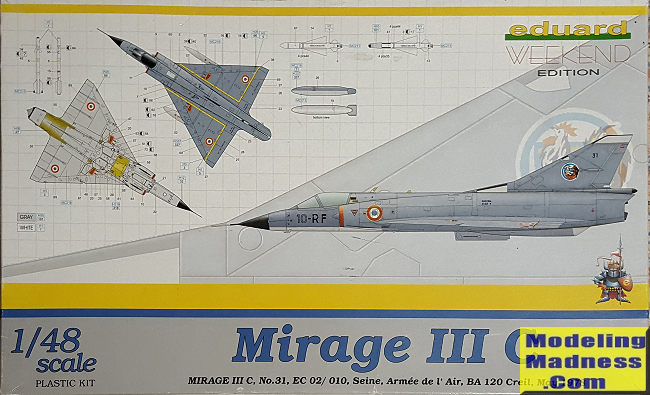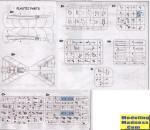
Eduard 1/48 Mirage IIIC 'Weekend Edition'
| KIT #: | 8495 |
| PRICE: | Bought mine 'used' with extras for $16 plus shipping |
| DECALS: | One option |
| REVIEWER: | Scott Van Aken |
| NOTES: |

| HISTORY |
The Mirage III family grew out of French government studies begun in 1952 that led in early 1953 to a specification for a lightweight, all-weather interceptor capable of climbing to 18,000 m (59,040 ft) in six minutes and able to reach Mach 1.3 in level flight.
Dassault's response to the specification was the Mystère-Delta 550, a sporty-looking little jet that was to be powered by twin Armstrong Siddeley MD30R Viper afterburning turbojets, each with thrust of 9.61 kN (2,160 lbf). A SEPR liquid-fuel rocket motor was to provide additional burst thrust of 14.7 kN (3,300 lbf). The aircraft had a tailless delta configuration, with a 5% chord (ratio of airfoil thickness to length) and 60 degree sweep.
The tailless delta configuration has a number of limitations. The lack of a horizontal stabilizer means flaps cannot be used, resulting in a long take-off run and a high landing speed. The delta wing itself limits maneuverability; and suffers from buffeting at low altitude, due to the large wing area and resulting low wing loading. However, the delta is a simple and pleasing design, easily built and robust, capable of high speed in a straight line, and with plenty of space in the wing for fuel storage.
The first prototype of the Mystere-Delta, without afterburning engine or rocket motor and an absurdly large vertical tailfin, flew on 25 June 1955. After some redesign, reduction of the tailfin to more rational size, installation of afterburners and rocket motor, and renaming to Mirage I, the prototype attained Mach 1.3 in level flight without the rocket, and Mach 1.6 with the rocket lit in late 1955.
However, the small size of the Mirage I restricted its armament to a single air-to-air missile, and even before this time it had been prudently decided the aircraft was simply too tiny to carry a useful warload. After trials, the Mirage I prototype was eventually scrapped.
Dassault then considered a somewhat bigger version, the Mirage II, with a pair of Turbomeca Gabizo turbojets, but no aircraft of this configuration was ever built. The Mirage II was bypassed for a much more ambitious design that was 30% heavier than the Mirage I and was powered by the new SNECMA Atar afterburning turbojet with thrust of 43.2 kN (9,700 lbf). The Atar was an axial flow turbojet, derived from the German World War II BMW 003 design.
The new fighter design was named the Mirage III. It incorporated the new area ruling concept, where changes to the cross section of an aircraft were made as gradual as possible, resulting in the famous "wasp waist" configuration of many supersonic fighters. Like the Mirage I, the Mirage III had provision for a SEPR rocket engine.
The prototype Mirage III flew on 17 November 1956, and attained a speed of Mach 1.52 on its seventh flight. The prototype was then fitted with the SEPR rocket engine and with manually-operated intake half-cone shock diffusers, known as souris ("mice"), which were moved forward as speed increased to reduce inlet turbulence. The Mirage III attained a speed of Mach 1.8 in September 1957.
The success of the Mirage III prototype resulted in an order for 10 preproduction Mirage IIIAs. These were almost two meters longer than the Mirage III prototype, had a wing with 17.3% more area, a chord reduced to 4.5%, and an Atar 09B turbojet with afterburning thrust of 58.9 kN (13,230 lbf). The SEPR rocket engine was retained, and the aircraft were fitted with Thomson-CSF Cyrano Ibis air intercept radar, operational avionics, and a drag chute to shorten landing roll.
The first Mirage IIIA flew in May 1958, and eventually was clocked at Mach 2.2, making it the first European aircraft to exceed Mach 2 in level flight. The tenth IIIA was rolled out in December 1959. One was fitted with a Rolls-Royce Avon 67 engine with thrust of 71.1 kN (16,000 lbf) as a test model for Australian evaluation, with the name "Mirage IIIO". This variant flew in February 1961, but the Avon powerplant was not adopted.
The first major production model of the Mirage series, the Mirage IIIC, first flew in October 1960. The IIIC was largely similar to the IIIA, though a little under a half meter longer and brought up to full operational fit. The IIIC was a single-seat interceptor, with an Atar 09B turbojet engine, featuring an "eyelet" style variable exhaust.
The Mirage IIIC was armed with twin 30 mm DEFA revolver-type cannon, fitted in the belly with the gun ports under the air intakes. Early Mirage IIIC production had three stores pylons, one under the fuselage and one under each wing, but a second outboard pylon was quickly added to each wing, for a total of five. The outboard pylon was intended to carry a Sidewinder air-to-air missile (AAM), later replaced by Matra Magic.
Although provision for the rocket engine was retained, by this time the day of the high-altitude bomber seemed to be over, and the SEPR rocket engine was rarely or never fitted in practice. In the first place, it required removal of the aircraft's cannon, and in the second, apparently it had a reputation for setting the aircraft on fire. The space for the rocket engine was used for additional fuel, and the rocket nozzle was replaced by a ventral fin at first, and an airfield arresting hook assembly later.
95 Mirage IIICs were obtained by the AdA, with initial operational deliveries in July 1961. The Mirage IIIC remained in service with the AdA until 1988. The type was also used with great success by the Israeli Air Force during the 1967 and 1973 wars. South African Mirage IIICZs remained in service for a considerable time due to a weapons embargo. Ex-Israeli Mirage IIICs were exported to other countries who wanted a capable aircraft but were unable to afford new aircraft or wanted to keep themselves free from any obligations to the US or other country.
The French Armée de l'Air (AdA) also ordered a two-seat Mirage IIIB operational trainer, which first flew in October 1959. The fuselage was stretched about a meter (3 ft 3.5 in) and both cannon were deleted to accommodate the second seat. The IIIB had no radar, and provision for the SEPR rocket was deleted, although it could carry external stores. The AdA ordered 63 Mirage IIIBs (including the prototype), including five Mirage IIIB-1 trials aircraft, ten Mirage IIIB-2(RV) inflight refueling trainers with dummy nose probes, used for training Mirage IVA bomber pilots, and 20 Mirage IIIBEs, with the engine and some other features of the multi-role Mirage IIIE. One Mirage IIIB was fitted with a fly-by-wire flight control system in the mid-1970s and redesignated Mirage IIIB-SV (Stabilité Variable); this aircraft was used as a testbed for the system in the later Mirage 2000.
| THE KIT |
 I
bought this kit at a sales site on Facebook. It included a photo etch zoom set,
canopy/wheel mask and a metal pitot. It also had most of the parts off the sprue
and packed in a bag along with some of the smaller parts assembled. I was
assured it was complete. It also came with an IAF decal sheet from the Hobby
Boss kit. I had built the Hobby Boss kit back in 2007 and liked it quite a bit.
I'm hoping this will be just as nice. .
I
bought this kit at a sales site on Facebook. It included a photo etch zoom set,
canopy/wheel mask and a metal pitot. It also had most of the parts off the sprue
and packed in a bag along with some of the smaller parts assembled. I was
assured it was complete. It also came with an IAF decal sheet from the Hobby
Boss kit. I had built the Hobby Boss kit back in 2007 and liked it quite a bit.
I'm hoping this will be just as nice. .
It comes with a five piece bang seat, control column, rudder pedals, and a cockpit tub with separate backwall for the cockpit. In this boxing, decals are provided for the panels. The nose gear well is built of six pieces and attaches to the back of the cockpit tub. Main gear wells are also made up of several parts and when done, install in the lower wing section.
Exhaust is made up of seven parts and when that is built, it, along with the cockpit assembly are trapped in between the fuselage halves. There is no indication of nose weight and I don't think any is required. Intakes are assembled in several different steps with the outside pieces not being installed until after the two trunking pieces are installed. These do not have a compressor face, just a blank section. So narrow is the intake that one won't see this anyway. Once the wing is installed, then the outer intakes are glued on.
The kit has separate elevons and the instructions warn you not to glue the rear section of the wings. A bit of a glitch in the instructions shows these items being installed before the actuator fairings are glued in place. The kit does provide separate outer fairings if one is to include missile rails for Sidewinders.
 The rest of
the build consists of installing the landing
gear and gear doors. These all have actuators and you are provided with
alignment diagrams to ensure you have the main gear items in their proper place.
The canopy can be posed open or closed and you get a ladder. A standing pilot
figure is also provided.
The rest of
the build consists of installing the landing
gear and gear doors. These all have actuators and you are provided with
alignment diagrams to ensure you have the main gear items in their proper place.
The canopy can be posed open or closed and you get a ladder. A standing pilot
figure is also provided.
For things under wings you get the afore mention Sidewiders or Magic missiles, two styles of Matra 530 for the centerline. two styles of wing fuel tanks and a pair of rocket pods.
Instructions are well done with Gunze paint references. The lone markings option is a later scheme of blue-grey upper and silver-grey undersides. The aircraft is from EC 2/10 in 1978. Decals are quite nicely printed.
| CONCLUSIONS |
I'm a fan of this aircraft and am looking forward to completing this one. These are not complex aircraft so it should prove to be a fairly trouble-free build.
| REFERENCES |
https://en.wikipedia.org/wiki/Dassault_Mirage_III#Mirage_IIIC_and_Mirage_IIIB
May 2018
Copyright ModelingMadness.com. All rights reserved.
If you would like your product reviewed fairly and fairly
quickly, please
contact
the editor
or see other details in the
Note to
Contributors.
Back to the Main Page
Back to the Review Index Page
Back to the Previews Index Page